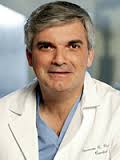19 Mar Promising Biologic Stimulates Blood Flow Into Critical Limb Ischemia
MedicalResearch.com Interview with:
Dr. Emerson C. Perin MD, PhD
Texas Heart Institute
Medical Director, BSLMC Catheterization Laboratory
Director, Research in Cardiovascular Medicine
Medical Director, Stem Cell Center
MedicalResearch.com: What is the background for this study?
Dr. Perin: Critical limb ischemia (CLI) is a devastating and debilitating disease characterized by reduced blood flow to the legs, frequently as a consequence of atherosclerosis. Patients with CLI have a poor prognosis and live with chronic pain and disability. The disease manifests clinically as pain during rest and compromised wound healing, often resulting in ulcers that don’t heal, which can lead to amputation. Moreover, Critical limb ischemia is a deadly disease, with an annual mortality rate of about 20%. The only effective treatment option is revascularization, but not all CLI patients are good candidates for this approach, and even for those who are, procedures can fail. These patients face a dismal prospect as no other effective treatment options are available. Clearly, new therapeutic strategies are desperately needed for this group of patients.
One of the most exciting new approaches for Critical limb ischemia patients who have no options is the concept of therapeutic angiogenesis—improving regional blood flow by facilitating the growth of blood vessels. This can be accomplished by delivering angiogenic factors to the area in need of improved blood supply. Hepatocyte growth factor (HGF) is a promising novel biologic for use in this way because it’s a powerful angiogenic agent that stimulates cell proliferation and migration. Delivering HGF into the ischemic limbs of patients with CLI may result in beneficial effects that help restore compromised blood flow to the area and encourage better healing of wounds. VM202 is a plasmid DNA that simultaneously expresses two isoforms of HGF, mimicking the way the body produces HGF. On the basis of favorable results from phase 1 clinical trials showing that gene therapy with VM202 was safe, well-tolerated, and potentially beneficial in patients with ischemic diseases, we conducted a phase 2, dose-escalation clinical trial in patients with Critical limb ischemia.
MedicalResearch.com: What are the main findings?
Dr. Perin: In this trial of 52 patients with Critical limb ischemia who were poor candidates for revascularization, we found that a series of intramuscular injections of VM202 into the affected leg improved wound healing and tissue oxygenation. Of the ulcers treated with high-dose VM202, 62% of them healed completely compared with only 11% of ulcers treated with a placebo agent. Tissue oxygenation improved the most in patients who received high-dose VM202 therapy. We also found that intramuscular injections of VM202 were safe and well tolerated as has been previously shown in phase 1 clinical trials.
MedicalResearch.com: What should clinicians and patients take away from your report?
Dr. Perin: : The take-away message is that gene therapy with VM202 may provide clinical benefits for patients with Critical limb ischemia who have no revascularization options. To be successful, this approach requires identification of a therapeutically effective gene and its efficient delivery and expression. We believe that VM202 may be potentially bioactive because the HGF gene produces high levels of the two natural HGF isoforms and the vector backbone used in the construct drives a high level of gene expression.
MedicalResearch.com: What recommendations do you have for future research as a result of this study?
Dr. Perin: Future research includes conducting a phase 3 trial to better understand the potential benefits of this novel approach. Our findings suggest that VM202 may be especially beneficial in treating non-healing ulcers, which are a serious symptom of Critical limb ischemia. These ulcers often lead to amputation because of the lack of medical therapies; therefore, VM202 may provide a much-needed therapeutic alternative for these patients. Other research areas of importance include studies aimed at improving our understanding at the molecular and cellular levels as to how pro-angiogenic factors can facilitate perfusion in ischemic areas.
MedicalResearch.com: Thank you for your contribution to the MedicalResearch.com community.
Citation:
Gene Therapy (8 December 2015) | doi:10.1038/gt.2015.11
Safety and efficacy of plasmid DNA expressing two isoforms of hepatocyte growth factor in patients with critical limb ischemia
M R Kibbe, A T Hirsch, F O Mendelsohn, M G Davies, H Pham, J Saucedo, W Marston, W-B Pyun, S-K Min, B G Peterson, A Comerota, D Choi, J Ballard,R A Bartow, D W Losordo, W Sherman, V Driver and E C Perin
[wysija_form id=”5″]
Note: Content is Not intended as medical advice. Please consult your health care provider regarding your specific medical condition and questions.
More Medical Research Interviews on MedicalResearch.com
Dr. Emerson C. Perin MD, PhD (2016). Promising Biologic Stimulates Blood Flow Into Critical Limb Ischemia MedicalResearch.com
Last Updated on March 19, 2016 by Marie Benz MD FAAD

